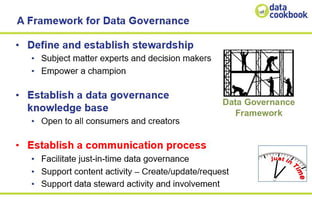 One of the three components of a data governance (data intelligence) framework is having a communication process which includes facilitating just-in-time data governance, supporting data governance content activity and assisting data steward activity. This blog post covers the concept of just-in-time data governance including goals and empowering data stewards.
One of the three components of a data governance (data intelligence) framework is having a communication process which includes facilitating just-in-time data governance, supporting data governance content activity and assisting data steward activity. This blog post covers the concept of just-in-time data governance including goals and empowering data stewards.
Avoid doing actual data governance tasks by committee. It's important to have committees. But the purpose of a data governance committee is not to do the actual data governance work. The committee should focus on buy-in, oversight, process and champions. The committee should not be defining definitions or resolving data quality issues since this would be an incredible waste of time. Instead data stewards should be empowered to do the actual data governance work which will happen when it needs to occur and not when the committee meets. Most of the time, data related items need to get resolved very quickly. You can’t wait for the committee to meet.
How do you facilitate what we call just-in-time data governance? For example, when someone does report a quality issue, do they know where to report it? And what happens when they do a report – who does it get routed to and what do they do with it?
There are questions asked and answered every day within your organization. You don't want to think about data governance as a project where you sit around and work on these 500 definitions or report specs or quality rules or whatever. It is something that should be a simple small part of your day-to-day tasks. Whenever a quality issue comes up or a new report is requested, or a definition is needed, then right then it gets updated to the knowledge base. It's just a practical approach to implement data governance directly into your existing processes.
Goals of just-in-time data governance (link to video) are:
- give people access to the information they need to use data appropriately and effectively when they need it
- support direct and immediate involvement of all necessary data stakeholders, where needed in the data processes
- give users ways to report problems or request information
- create processes that foster collaboration, communication, and sharing
- create tools that notify and alert people when there are changes to data that have impact on their work
- focus on facilitating the use of data, not stopping the use
- keep it simple and not create overwrought processes where you need five layers of approval or six people involved
If you would like additional information on just-in-time data governance, then please check out our “Succeed with Just-in-Time Data Governance” blog post or the recorded webinar titled “Data Governance Best Practice: Just-in-time Data Governance”. Hope that this blog post provides more information on the communication process which is one of the key foundations of data governance.
IData has a solution, the Data Cookbook, that can aid the employees and the organization in its data governance, data stewardship and data quality initiatives. IData also has experts that can assist with data governance, reporting, integration and other technology services on an as needed basis. Feel free to contact us and let us know how we can assist.
Photo Credit DGFramework_Knowledgebase_BP #1070

